Salvador is the fourth most populated city in Brazil, as has been attracting more and more tourists interested in the local culture and paradisiac beaches. The city also houses many great neighborhoods to either live in, or just accommodate yourself temporarily while you enjoy your trip.
Amongst the best neighborhoods to stay in Salvador are the city’s historical center, the Pelourinho, the Corredor da Vitória district, and Barra, pretty famous during Carnaval. Other great neighborhoods in Salvador include Brotas, Alphaville, Ondina, and Cabula.
In today’s post, we’re gonna provide you with a full Salvador neighborhood guide, showing you what are the best districts in the city. We’ll highlight all the best places to visit in each of them, as well as give you some pointers on where to eat, where to go to have fun, and also talk about some of the neighborhoods to avoid in Salvador
1. Corredor da Vitória (Campo Grande)
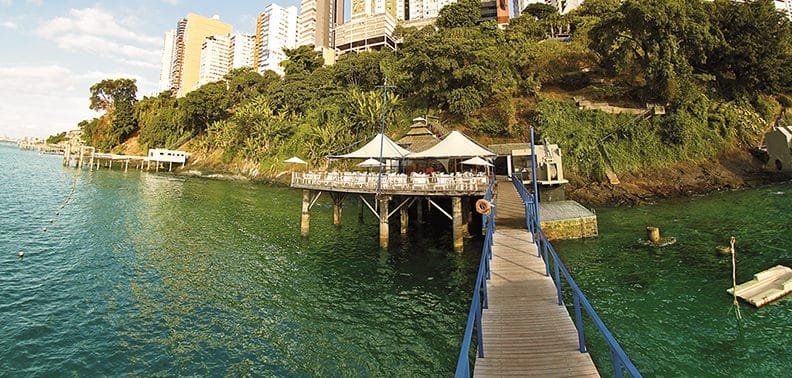
Corredor da Vitória (also known as Campo Grande) is a mainly residential neighborhood in Salvador who got its name from the Nossa Senhora da Vitória church, founded in the 16th century. Aside from this beautiful and historical construction, there are several other cultural sites in the Vitória district, like the Arte da Bahia and Carlos Costa Pinto museums.
Overall the Vitória neighborhood in Salvador is a very nice place to live or accommodate yourself in the city during a trip, it’s got big green areas everywhere and has the beautiful Baía de Todos os Santos as its landscape. It also houses the training center of one of the most popular soccer teams in town, Esporte Clube Vitória.
Leisure
Aside from the aforementioned Esporte Clube Vitória training center (which you maybe even can watch a match if the timing is right), Vitória also has 3 pretty cool museums to visit, the Museu Geologico da Bahia (which features fossil and mineral collections), the Carlos Costa Pinto Museum (which houses an impressive colonial set) and the Museu de Arte da Bahia, the oldest museum in the state.
The Vitória district also has 2 movie theaters, namely the Sala de Arte do Museum and a movie theater located inside the Carlos Costa Pinto Museum, which is only open once a week and only exhibits old movies in their weekly schedule.
And of course, if you’re planning on staying or living in a coastal district, the main thing you want to know is about the beaches, right? The nearest beach in Vitória is the Porto da Barra beach, which houses the Mahi Mahi pier, an exclusive space inside the Sol Victoria Marina.
If you’re not staying at the hotel, you can pay the daily fee in order (a little under USD 10.00) to use the deck, which features restaurant (that serves many local gastronomy dishes), a bar service and a waterslide that flows out to the Todos os Santos Bay. The water is crystal clear and warm, you won’t wanna go nowhere!
Safety
Unfortunately, safety is still an issue in many neighborhoods in Salvador, and Vitória is one of the most affected districts. According to the Brazilian Institute of Geography and Statistics (IBGE) and to the Department of Public Safety (SSP), the violence has decreased in the area within the past couple of years, but visitors must still be careful around town.
Gastronomy
The Corredor da Vitória gets its name for being a big corridor, filled with bars and restaurants. Of course, the Mahi Mahi pier restaurant, which we mentioned before, is one of the most famous places in the area, but there are several other great places to eat, like the Atelier do Sabor bistro and the Canela com Pimenta restaurant.
The Marina Restaurant is also very popular in the Vitória district, with a lot of people praising it for its traditional Baiana (original from Bahia) culinary. In regards to the local bars, the Cantinho da Jô bar has a breathtaking view of the ocean, while the 275 Espetaria bar serves delicious skewers while you have a drink.
Accessibility
The Corredor da Vitória neighborhood connects Cidade Velha (where the old downtown used to be) to Barra. Therefore, in regards to public transportation, several bus lines cross the district, and the closest station is Lapa.
2. Centro Histórico de Salvador (Pelourinho)
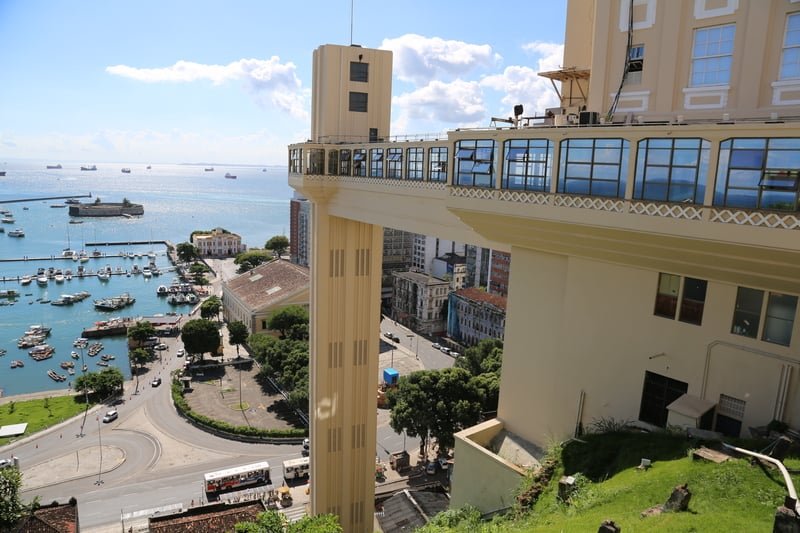
The neighborhood is a great contrast between the contemporary and the historic, allowing residents and visitors a very clear vision of what Cidade Alta and Cidade Baixa are. It has an intense bohemian and cultural flair and is a mandatory stop for everyone who visits the city.
This is a region where square meters are not as highly valued, with a more affordable cost of living. The Elevador Lacerda, Pelourinho and Mercado Modelo are some of its attractions as described in our next topic.
Leisure
Housing part of the historic center of Salvador (the other part belongs to the Santo Antônio Além do Carmo district, which we’ll take a look more throughly up ahead), expect A LOT of cultural attractions at the Pelourinho.
The Fundação Casa de Jorge Amado, for example, is one of the biggest tourist attractions in the neighborhood, concentrating a lot of the work of late Brazilian author Jorge Amado. The Nossa Senhora do Rosário dos Pretos Church is another of the neighborhood’s highlights, as it was built in the 18th century and its interior is full of Portuguese tiles and neoclassical altars with images of Nossa Senhora do Rosário and other saints.
During Summer, you can watch the Olodum’s musical rehearsal on Tuesdays and Sundays. It is definitely must for anyone who is enchanted by Bahia, as the group represents the soul of the state’s culture. It is the most traditional manifestation of afro music in Bahia, composed of a mixture of afro beats, samba and reggae.
Safety
Unfortunately, in the region, the crime problem hinders the development of tourist activity in the place, as well as problems related to urban cleanliness and drug trafficking.
According to users on Trip Advisor, you are safe at Pelourinho as long as you remain in the common areas, which is where the bars, restaurants, museums and hotels are located. Other than that, do not walk around the neighborhood aimlessly and remain alert especially at night.
Gastronomy
After all that walking around the Pelourinho’s hills, nothing better than sitting at a nice restaurant and feast, right? Zanzibar serves traditional African food, and brings exotic African dishes, such as “ébubu fulô”, a fish course seasoned with ginger and shrimp sauce and a delicious plantain puree.
Senac’s restaurant also houses the Bahian Gastronomy Museum, the SESC Theater, a candy and book shop and a self-service restaurant. The restaurant features a buffet typical of Bahian cuisine with 42 dishes and 12 types of desserts.
At last but not at least, Cafélier is a small but very cozy space with a beautiful view of the sea and part of the city. It also offers options for pastas, teas, pies, snacks, omelettes, ice cream, and “pinguiches”, handcrafted ice cream sandwiches. It is a great place to watch the sunset from!
Accessibility
Buses are not allowed to circulate in Pelourinho, causing them to stop at Praça da Sé station, next to Elevador Lacerda.
The most recommended way to get to Peourinho by public transportation is to take Line 2 of the Metro to the Acesso Norte station, and from there connect with Line 1 to Campo da Pólvora station. From Campo da Pólvora to Pelourinho it is about 1 km on foot.
The path must be completed on foot for about 1 km. This route is not recommended for people traveling with large, heavy luggage or with limited mobility, as the Pelourinho stone floor does not help transporting suitcases with wheels.
3. Alphaville
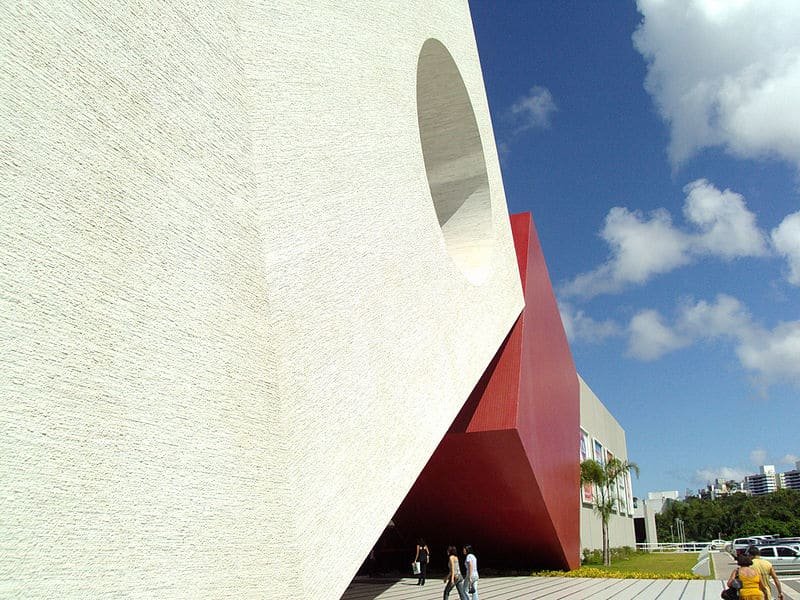
It is one of the best neighborhoods in the city and it is close to Salvador International Airport. Considered a high-end neighborhood, it has a good residential and commercial structure and it is also close to the Administrative Center of Bahia.
This is a relatively new neighborhood, which has become a high-end commercial and residential hub. Many consider that its structure resembles that of neighborhoods in São Paulo and also that it is an excellent place for real estate investment.
Leisure
The Paralela Mall is one of the main entertainment areas in the Alphaville district, housing aside from several stores, 2 floors worth of different places to eat. The mall also houses a movie theater, so it is a convenient place to go if you should need to grab a quick bite or entertain the kids for a while.
Safety
The neighborhood is known for its good commercial and residential infrastructure, high security and local sustainability. Overall, it is a safe region that attracts mostly students seeking comfort and quality of life.
Gastronomy
Aside from all the options at the Paralela Mall’s food court, there are many places to choose from whether you want to have a full meal or just a couple of drinks. The Alemto & Don Alberti restaurants, for example, serve the best Brazilian traditional cuisine dishes, like Maniçoba (made with cassava leaves), and Sundried Meat.
If you’re interested in something a bit more practical, Bravo is a place that serves one of the best burgers in the Alphaville district, as well as being a famous place for beer lovers. For the fans of oriental food, the Joy Restaurant is one of the best rated places according to Google, with many people praising the restaurant for its fresh menu.
Accessibility
As we stated earlier, Alphaville is a relatively new planned neighborhood that has become a high-end commercial and residential hub. The site offers a privileged location, close to the administrative center of Bahia and with easy access to Salvador International Airport.
The closest subway station to Alphaville is the Flamboyant station, located in the city’s Subway Line 2.
4. Horto Florestal
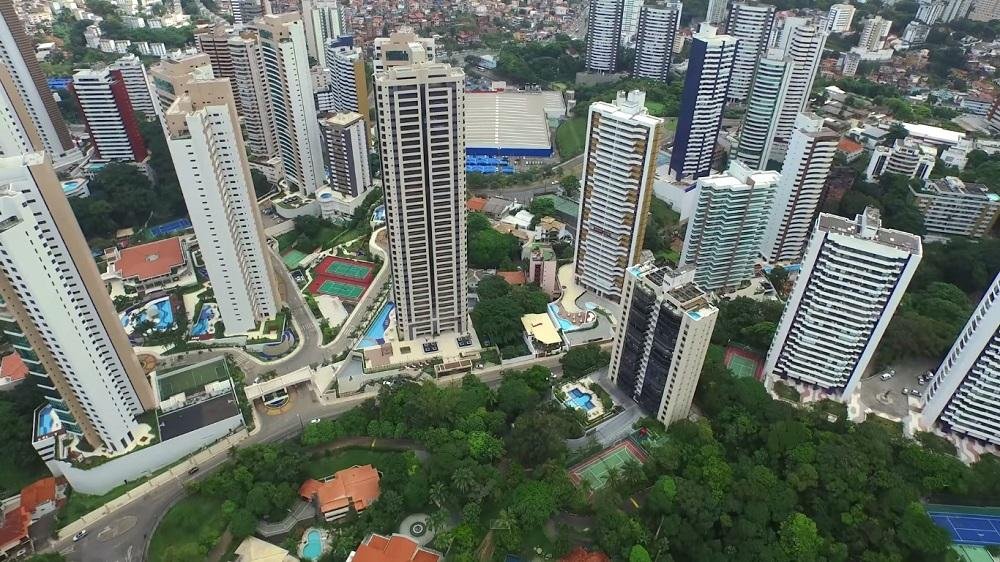
Credit: Naize Corretora
Horto Florestal is the place of diversity and luxury. At the same time that you will find tall residential buildings, you will bump into historic houses. The region is one of the richest in the city, with easy access to the main roads.
Leisure
The Horto Florestal district is a brand new neighborhood in Salvador. It used to be considered a part of the Brotas neighborhood (which we will talk about more thoroughly on a following topic) but has emancipated itself and became its own district in 2020.
For that reason, most of the activities are concentrated in the Brotas area, so make sure to check that topic later on to see what are the attractions in the district.
Safety
The joint prevention and monitoring work increases the safety of those who live or work there. The cameras spread across the streets and the proximity to police stations also make the neighborhood safer. At Horto Florestal, you’ll see plenty security cars passing through the streets.
The neighborhood has a specialized surveillance team, hired by the residents’ association, which works in cooperation with the military and civil police.
Gastronomy
Racletto is a very good place in the neighborhood, specializing in intimate raclette, which at the same time refers to the style of a Swiss castle internally. At the Ori Restaurant, expect to have the best of the northern Brazilian cuisine, as the restaurant is considered one of the best in Salvador.
Accessibility
The neighborhood has a very efficient public mobility system for those people who use public transport to move to other places. The closest station to the Horto Florestal neighborhood is Avenida Juracy Magalhães.
5. Barra
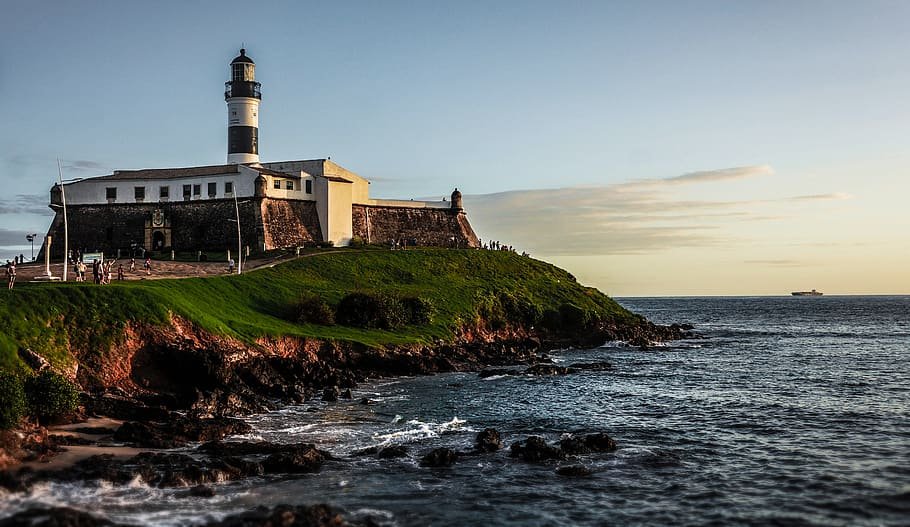
The Barra neighborhood is part of the city’s Carnival route, where several electric trios pass through. It is part of the South zone and has a beach of the same name, ideal to enjoy with the family. It is also one of the noblest neighborhoods in the city and has excellent options of bars and restaurants.
Just like Ondina, this is one of the places for those who want to combine beautiful landscapes with fun and a good standard of living. This is perhaps the most famous neighborhood in the capital, as it is home to Farol da Barra, a symbol of the city.
Leisure
The Barra Lighthouse is one of the city’s most beautiful architectural heritage sites, is a mandatory stop for selfies. The Fort where the Farol da Barra is located houses the Museu Náutico da Bahia, which has a historical collection made up of objects from different eras, some of them submerged for up to 300 years.
The beaches at Barra are fun for families, athletes, “partygoers”, locals and tourists. The waterfront is full of people on the bike path riding bicycles, running, walking, skating or rollerblading. The sunset at the Barra shoreline is absolutely breathtaking.
Safety
According to the IBGE (Brazils Institute of Geography and Statistics), it is considered one of the safest places in the capital, providing residents with tranquility and comfort in their routine. Praia do Porto da Barra is perhaps the most traditional among visitors, in addition to being the setting for numerous TV and movie sequences, especially when the theme is Carnival, so security is increased as it is a tourist spot.
Gastronomy
Very close to Farol da Barra, there is a Bistrô Restaurant with very interesting modern and contemporary cuisine called Du Chef Art and Gastronomy, which is a great option if you’re looking for something more sophisticated.
Coznha de Fogo restaurant is known for two things: juicy meat and ember flavor! Known as one of the best meat restaurants in the city, one of the highlights is the smoked gherkin conserve.
And at last but not at least, Barravento is a beautiful place facing the sea, with great service and has dishes with seafood, pastas and risottos, as well as wines, draft beers and desserts. It is well located, in the center of all the happenings in the neighborhood, but, even so, it has a very peaceful environment, great for groups and families.
Accessibility
In December 2020 it was announced that the city’s subway system would expand and Barra will be contemplated with a station, but so far, there are no subway stations in the district. The nearest subway station is Lapa.
6. Ondina
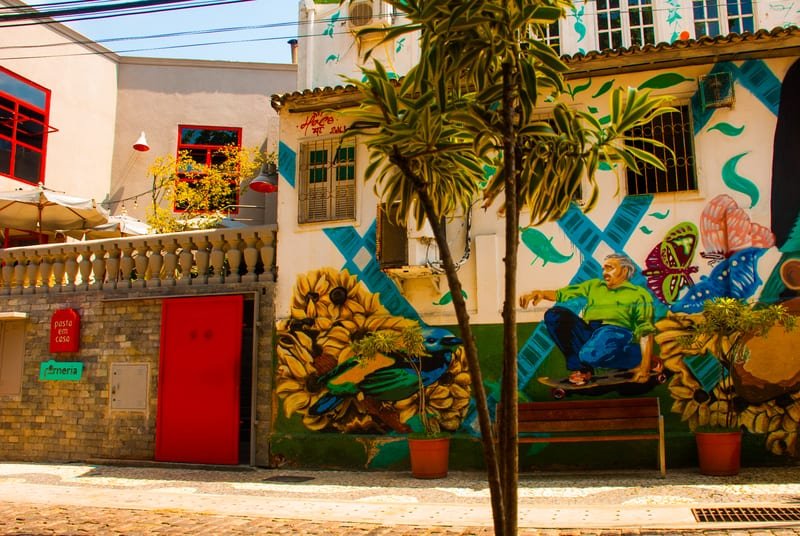
It is also one of the neighborhoods in which the carnival circuit of the electric trios takes place. The Federal University of Bahia (UFBA) and the local zoo are also located there. It is highly valued, has many students among its residents and has a good selection of restaurants.
The beach is mostly frequented by families, so if you’re looking for a nice place to enjoy some peace and quiet with your family, Ondina may be the right spot.
Leisure
Starting at the Ondina beach in Salvador, there you can enjoy the whole day with lots of fun and tranquility. In addition to the natural beauty, you can let your children play peacefully and practice sports such as racquetball, volleyball and football.
If you’re feeling up to it, near Praia de Ondina in Salvador there are several cool tour options, such as the Governor’s Palace, the famous Alto de Ondina viewpoint and the city’s zoo. This is valuable advice for anyone looking for tips on what to do with children in Salvador.
Safety
Just like Alphaville, Ondina is also known as a privileged region, being one of the safest neighborhoods in the city. The fact that Ondina is a very touristic spot in Salvador also contributes to it having more reinforced police in this area of the city.
Gastronomy
Accessibility
7. Caminho das Árvores

Camimjho das Árvores is one of the city’s luxurious neighborhoods, with several condominiums and diverse commerce. It has highly recommended bars and restaurants. It was once considered an extremely residential place, but over the years, it has become a mixed neighborhood and has dozens of business buildings.
Leisure
In recent years, Tancredo Neves, the neighborhood’s main avenue, has been populated by several stores and businesses aimed at the upper class, which has increasingly increased the value of the property in the area. In the neighborhood, you can find several boulevards amid residential buildings.
The Bahia Mall (Shopping da Bahia) is the district’s main shopping center, which can be easily accessed through the city’s subway system. The mall is pretty big, with a lot of users on TripAdvisor commenting on getting lost a few times in it. Given its size, expect to find anything you should need here, from stores to restaurants.
Safety
The neighborhood is considered safe, but there is little movement of people on foot at night, so it is always good to be careful.
My advice would be to call in an Uber or a car service when you’re going out at night, especially if you’re with a larger group (so you can share the fee).
Gastronomy
The Caminho das Árvores district is considered a strong gastronomic center, so you can count on having a lot of places to taste different types of food. Since we’re in Salvador, if you want to try the Baiana cuisine in a non-traditional way, make your way to the Origem restaurant, which specializes in flipping the script on traditional dishes.
On the Italian cuisine department, the Filetto Ristorante is one of the best-rated local restaurants on Google, followed closely by Bella Napoli. Still talking European cuisine, you’ll be able to try not only Spanish and French dishes on A Casa Vidal, but they also have an excellent Italian menu.
The oriental gastronomy is also present in the Caminho das Árvores district, with the Gattai restaurant being one of the major references. If you’d like to eat some seafood (just not Japanese), Al Mare is the place to go.
Accessibility
The Caminho das Árvores district houses subway station Pernambués. Depending on what is your schedule, the neighborhood can be a little out of hand, as it is a bit distant from certain locations. For example, if you’re planning on coming to Salvador during Carnaval, you could be looking at driving a good 6 miles in order to get to where the Carnaval blocos take place.
Other than that, there are a lot of bus lines that cross the district, just check what is the estimated schedule for the lines at night, as some buses stop running after a certain hour.
8. Brotas
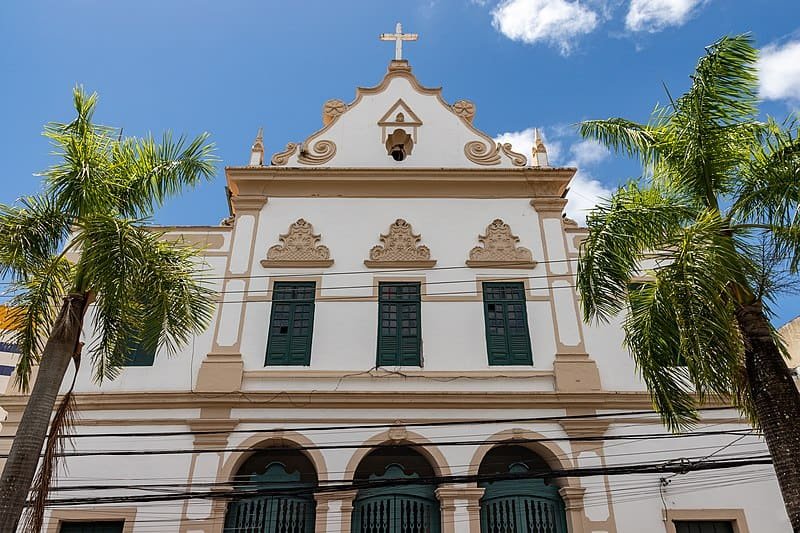
Here you will find one of the largest neighborhoods in the city, divided into sub-neighborhoods and sub-districts. There you will find everything, schools, offices, condominiums and stores.
Leisure
The main buildings in Brotas are the Church of Nossa Senhora de Brotas and the Baptist Church of Brotas. The Cine-theater Solar Boa Vista (Cine Teatro SOLAR Boa Vista) is one of the 17 cultural spaces maintained by the State Cultural Foundation (FUNCEB), an institution linked to the State Department of Culture.
The only theater located in the Brotas neighborhood, SOLAR is located in Parque Solar Boa Vista. The Solar Boa Vista Park is a great place to spend time outdoors, as its extensive green area houses sports courts and a big children’s park for the kids.
Safety
In 2006, the Brotas neighborhood had a Human Development Index (HDI) of 0.968, favorable rates equal to those of Norway, which is a developed country that has presented the best results for several years in the ranking.
Unfortunately, since then, the criminal group called BDM (Bonde do Maluco) exercises control over drug trafficking in Bahia, operates in the neighborhood. In 2018, it was elected by locals as one of the neighborhoods with most car thefts in Salvador.
Gastronomy
Being so big, Brotas houses many types of bars and restaurants to chose from. There’s the La Pulperia restaurant, which especializes in Argentinian food. The place has a very intimate and cozy vibe, being a great option for a romantic evening.
But if you want to eat some delicious local food, maybe the Midispache Gastronomia restaurant could appeal more to you, especially with traditional dishes like baião de dois and bobó de camarão.
In regards to places to have a few drinks, bars Serafim and Petiscaria Quintal de Casa are two of the most popular places in Brotas, mainly because they perfectly reflects Salvador’s chill and relaxed vibes. And if you’re looking for something a little fancier, maybe the Boteco do Vale bar is the choice for you, as they have delicious drinks and sophisticated appetizers.
Accessibility
Geographically, Brotas is a central neighborhood in Salvador, so expect bus lines that will take you anywhere in the city. The district also houses the Brotas subway station, which facilitates getting around Salvador.
8. Rio Vermelho

Considered a bohemian neighborhood and one of the most visited in the city. It is where Jorge Amado’s house is located, which is open to visitors, and Largo da Dinha, where Dinha’s acarajé is located, one of the best in the region. It is quite safe and its graffiti-covered buildings are popular with tourists.
Leisure
Known for its trendy and eclectic vibe, Rio Vermelho gets lively in the late afternoon when the bars and live music venues near Largo de Santana fill with people. Several unassuming but iconic food stalls sell fried bean balls, or acarajé, a local favorite.
The Rio Vermelho Market – affectionately called Ceasinha – offers a great variety of products and services, from fresh fish, flowers and even beautiful handicraft items. The prices there are much better than those found in other tourist attractions in Salvador, perfect for securing souvenirs for the whole family.
The beaches include Praia do Buracão, famous among LGBT people, Farol da Barra Beach (4.3 km away) and Porto da Barra Beach (4.5 km away)
Safety
This is technically one of the safest places in the city, as it has an army base located in it, but according to recent surveys, the truth is a bit far from that.
Although it doesn’t get first place when it comes to armed robbery against passerbyers, Rio Vermelho is still a bit dodgy when it comes to safety, so be aware of that.
Gastronomy
The Blue Praia Bar, a restaurant that combines the Bahian flavor with the beauty of Praia do Buracão, complete with a breathtaking view. Bahian and Mediterranean cuisine.
Another highlight of Ceasinha is the Gourmet Square, with independent access and different opening hours. There, visitors can enjoy cuisine that combines regional and international flavors, full of bars and restaurants that bring families and friends together during happy hour.
If you like live music, this is also a great option to enjoy.
Accessibility
There are no subway stations in the neighborhood, but you do have the BRT bus that passes around all the time to take you.
Culture
On the edge of Rio Vermelho Beach, the Casa de Iemanjá is a place that exudes energy and provides a wonderful view of the Salvador sea. In a small and simple space, the house houses several images and offerings left for the orixá. It’s a space to give thanks, make requests and learn a little about the history of Bahian culture.
If you are in the city around February 2nd, that’s when the Festa de Iemanjá takes place: a ritual in which fishermen take the gifts left at the house to the high seas, asking for plenty of fish and a calm sea

9. Cabula
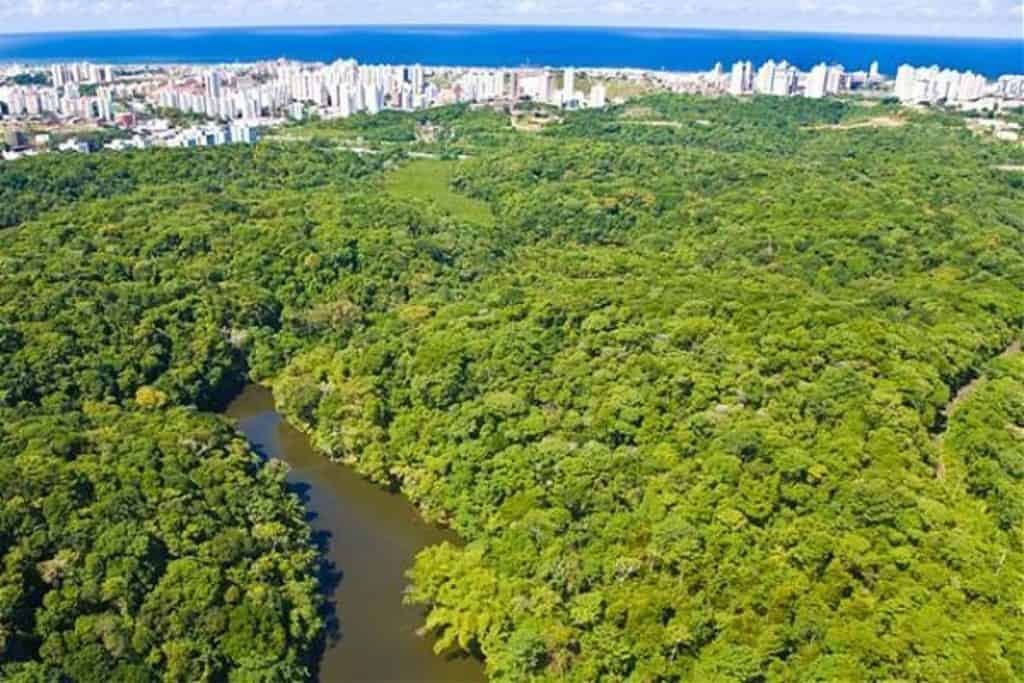
It’s time for you to discover one of the fastest growing middle class places in the city. Thus, good health services and educational institutions were established there. It has diversified commerce and a good service structure, with hospitals and schools.
Leisure
The Cabula district features a lot of cultural and historical places, such as the Museu digital e artes, which consists of a virtual tour through the trajetória of the quilombos, the free slaves.
Community-based tourism mobilizes residents to create cultural and artistic expressions in the localities. Examples include the Cabula Art and Culture Collective.
Mata do Cascão is a preserved area of the Atlantic Forest, located behind the barracks of the 19th Army Hunter Battalion. The vegetation has several species and also protects the sources of the Cascão River. In Horto Florestal is located the first water dam that supplied the city of Salvador.
If you’re interested in getting to know more about the Candomblé (an African based Brazilian religion), you can visit several centers (or terreiros as we call in Brazil) scatted around the Cabula district, like Ilê Axé Opó Afonjá and the Terreiro Tumbenci.
Other attractions narrates the history of the neighborhood and are tourist attractions such as the centuries-old mansions, the Caetano Veloso Theater and the Legislative Memorial.
Safety
It was listed as one of the least dangerous neighborhoods in Salvador, according to data from the Brazilian Institute of Geography and Statistics (IBGE) and the Secretariat of Public Security (SSP) released on the neighborhood-by-neighborhood violence map by Correios in 2012.
It placed among the quietest neighborhoods as a result of the homicide rate for every hundred thousand inhabitants per year (with reference from the UN) having reached the lowest level, with the indicator “0”, being one of the best neighborhoods on the list.
Gastronomy
The Cabula neighborhood is the type of place that offers residents countless options. The restaurants range from the most renowned to those offering homemade food, to fast food options in nearby shopping malls.
The Paraíso Tropical restaurant is arguably the most famous in the district, it stands out for its moquecas seasoned with natural fruits and herbs. The house’s desserts are also based on local fruits, such as cupuaçú.
Bar and Restaurante das Marias is ideal for those who are staying in Cabula and want to eat good Bahian and homemade food without having to go far. Furthermore, it is highly recommended for those who want to do it at a bar and have a cold beer with friends.
In the heat of Salvador, having a store specializing in popsicles nearby isn’t bad at all. Picoleteria Tropical, located on Rua Silveira Martins, promises the “real flavor of fruits” in its products. There are more than 70 flavors available to the customer. In addition to fruits, there are flavors such as peanuts and tapioca on the menu.
Accessibility
The neighborhood offers 7 bus lines, however, several other bus lines travel through the locality, as the neighborhood is one of the largest in the region and its main road is Rua Silveira Martins, which serves as an access point to several other communities of the area.
In March 2018, the newspaper Correio mentioned Cabula “among the six most desirable neighborhoods to live in Salvador”, indicating “improved urban infrastructure, service and commerce offering, easy access to the city’s main roads
10. Itapuã
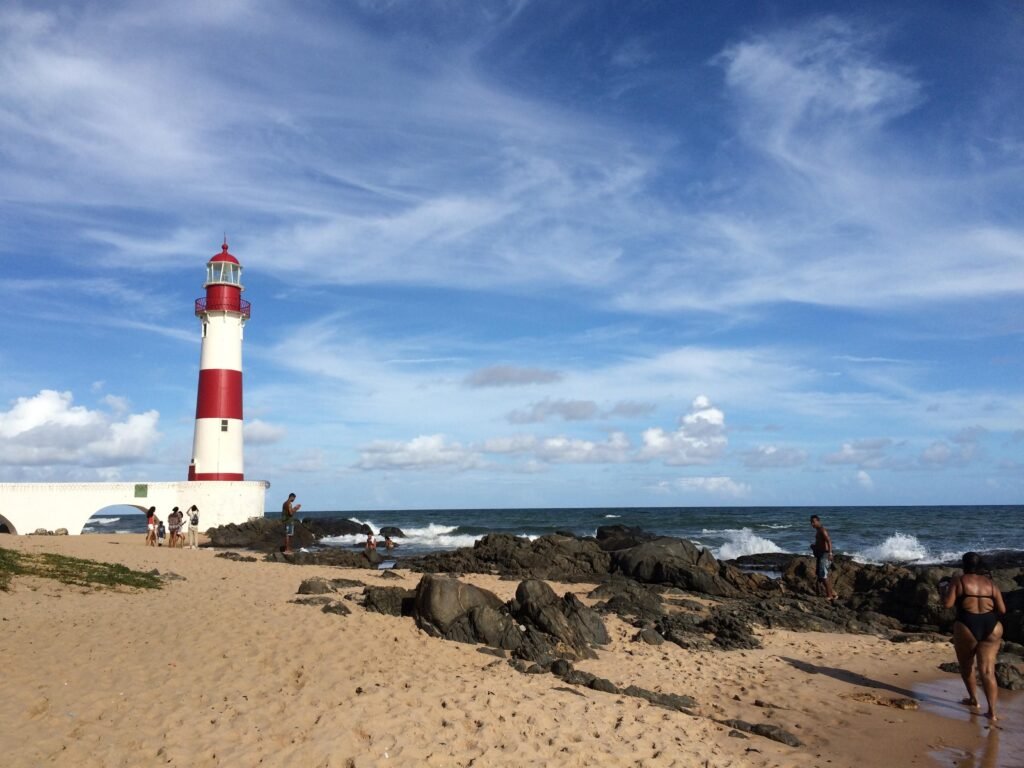
Credit: WikiCommons | TMbux
As it is further away from the Center and residential, this is a very quiet location, but has everything you need to live well. Beach, vast commerce, good gastronomic options and its own lighthouse, are some of the attractions of yet another of the best neighborhoods in Salvador.
Its beaches have white sand and calm waters. It has many houses and its cost of living is lower, as it is not so close to the center.
Safety
The Itapuã neighborhood leads the number of robberies in Salvador. According to the local police, Itapuã is considered the most dangerous neighborhood to walk around.
In 2019, Argentine tourist Luiz Daniel Barizone was killed with a knife blow to the back after having two cell phones and R$100 stolen by two suspects, one of them armed. Before leaving the hotel, the family was warned by staff that the area was dangerous for nighttime walks.
So, whenever you need to leave your hotel, your best and safest bet is to call an Uber to drive you around.
Gastronomy
To name a few of the places you can go to have some delicious food around Itapuã, the Barraca Bora Bora is a nice option. It is located in Pedra do Sal, a less busy part of Itapuã, but swimming in the sea is only recommended at low tide. There is plenty of space and plenty of outdoor tables.
Acarajé da Cira
If you notice a pompous queue at Largo de Itapuã around 5pm, know that there’s your chance to try the the traditional acarajé from the Cira team, sometimes awarded as the best in the city.
And if you’re looking to have a fancy dinner, then you must go to the Mistura restaurant. What was once a simple beach stand, transformed into the chicest place in the neighborhood!
11. Pituba
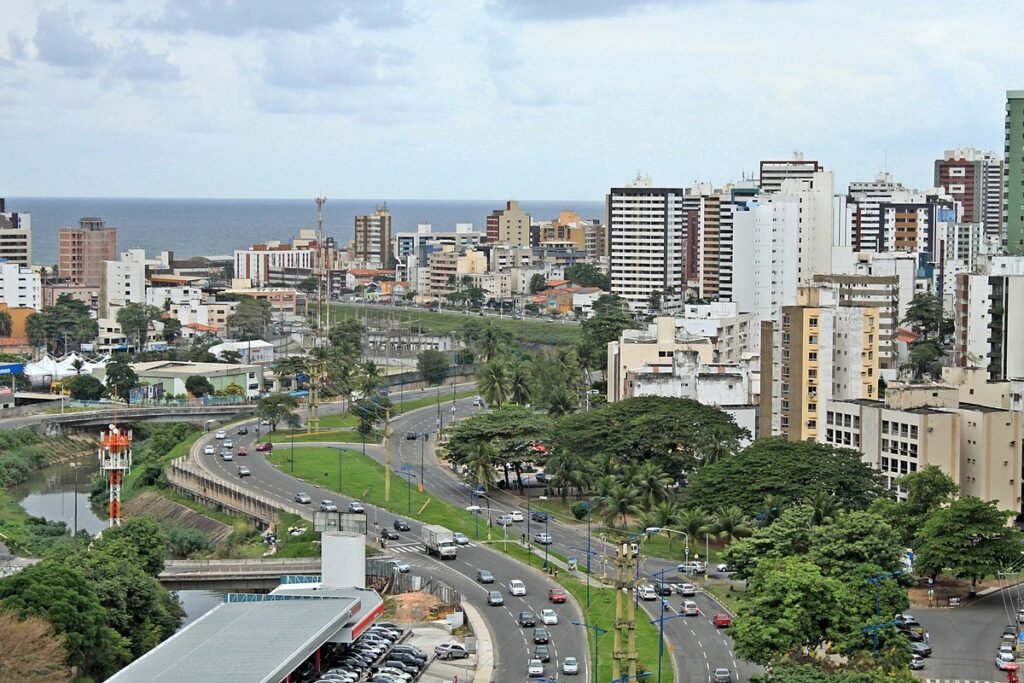
Credit: WikiCommons | Sitenl
It is considered an extension of the Caminho das Árvores neighborhood, and as such, it is among the noble neighborhoods of Salvador. The average housing prices can be considered high, but it has good infrastructure and diversified commerce and is close to the city’s oldest shopping mall, Iguatemi.
Leisure
Unfortunately the beach in Pituba is not proper for swimming, but you can do that in the neighbor district, Amaralina.
You can also visit some of the historical sites of Pituba, such as the Convento de São Francisco Church. The architecture is astonishing, with several pieces painted with real gold. The church is one of the most beautiful Brazilian Baroque buildings still standing (if you want to know more about the Brazilian Baroque art movement, take a look at this post we made).
Safety
In 2006, the Pituba neighborhood had a Human Development Index (HDI) of 0.968, favorable rates equal to those in Norway. On the other hand, a recent survey pointed out the neighborhood as the leader in the number of records of cell phones thefts.
Gastronomy
Right by the Pituba Beach, there are tons of restaurants and bars to choose from day and night. One of the things I love about Salvador is that, much like Rio de Janeiro (where I live), the overall vibe of the city is pretty chill, and to me there’s nothing better than sitting at a bar to have a beer while still wearing flip flops, you know? If you’re a fan of that too, the Pituba Beach shore line is packed with those.
There are also some very good bakeries in Pituba, like Cheiro & Pão and Artesanali. These are interesting choices to have if you’re on a hurry and just want to grab a quick bite to eat, as both of them serve delicious sandwhiches. They are also perfect for a cup of coffee in the middle of the afternoon.
In regards to restaurants, the highlights according to TripAdvisor goes to Joy Cozinha Oriental (which especilizes in oriental cuisine), Vinoteca Adega de Comer (great winery to do some wine tasting while munching on different types of cheeses), and Betini Forneria, one of the best-rated pizza parlors in the Pituba distric.
Oh, and don’t forget to stop by at Armacen Pepe for the best ice cream in Salvador!
Accessibility
In February 2021, the city of Salvador has started to work on the construction on 3 new subway stations, which will the be first inaugurating the system’s Line 3. One of these stations will be housed by the Pituba neighborhood, which will facilitate the access to this area if you want to use public transportation,
12. Santo Antônio Além do Carmo
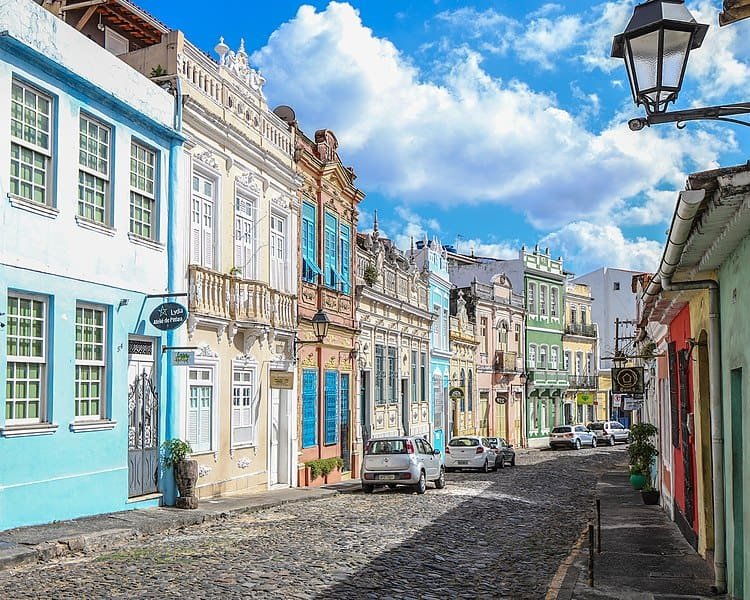
Also part of the Historic Center of Salvador, the neighborhood of Santo Antônio Além do Carmo is just beyond Largo do Carmo. The literal name, full of religious influences, also describes that, there, many of the tourist attractions are churches and sacred monuments, as well as colonial houses.
Santo Antônio is an option further away from the main points of downtown Salvador and, therefore, has less tourist traffic and a little more security.
Also because it is further away from Pelourinho, Santo Antônio has a more residential profile, which means that the offer of places to stay is limited to seasonal apartments instead of regular hotels.
Leisure
Start at the historical complex Conjunto Carmelita, started in the 16th century by the Carmelites when they landed in Brazil. With the churches of Carmo, the monastery, now transformed into a hotel and the catacombs, open to visitors.
Safety
The policing of Além do Carmo, Pelourinho and its surrounding areas is seen almost in every square, but better safe than sorry. Do not leave materials and valuables on display, like rings and necklaces.
Gastronomy
In the middle of Rua do Carmo, Cruz do Pascoal is the oratory symbol of the neighborhood, bustling with a hub of bars and restaurants. Bohemian, party-loving and very well preserved, the place has attracted people day and night, when tables are set up on the sidewalks.
Bar Cruz do Pascoal is one of the most traditional in the capital of Bahia and was opened more than 60 years ago, serving as a setting for soap operas and films.
Cafélier is one of the places you can’t miss when visiting the neighborhood. Charming and elegant, the decor is reminiscent of 20th century Parisian cafés and the photos of Brazilian singers such as Cauby Peixoto and Bibi Ferreira are a tribute to the Golden Age of Radio.
“Daqui do Alto” serves the “arrumadinho” dish on a clay tile for up to four people. This dish in Bahia consists of string beans cooked with spices and seasonings, garlic farofa, with sun-dried meat or beef jerky and paio.
Neighborhoods To Avoid in Salvador (Bahia)
Although one of the main touristic destinations in Brazil, Salvador is not exactly known to be a safe city for either locals or tourists. The aforementioned neighborhoods are indeed considered the best in town, but as you could gather from our safety tips, some of them are still affected by criminality.
Salvador has unfortunately been experiencing an increase in regards to crimes, mainly due to the fact that the local narcotraffic gained a lot of power within the past few years. In a study from 2017, Salvador has been noted as the 5yh most dangerous capital in Brazil, surpassing other important touristic cities such as São Paulo and Rio de Janeiro.
Based on the reports from Salvador locals and app drivers who run all over the city in this 2018 piece, there are a few districts that they don’t recommend going to, especially if you are a tourist. Most people state they have been robbed a few times in the following districts, saying that cell phones and vehicles are the main targets for thieves.
Nazaré
Pernambués
Imbuí
Dois de Julho
Federação
Periperi
Ilha Amarela
Águas Claras
Pirajá
Castelo Branco
Dom Avelar
Boca da Mata
Pau da Lima
São Marcos
Tancredo Neves
Porto Seco Pirajá
Cajazeiras
Fazenda Grande
Valéria
Palestina
Cover Photo: Pelourinho (credit: Celso Castro Júnior | Flickr)
